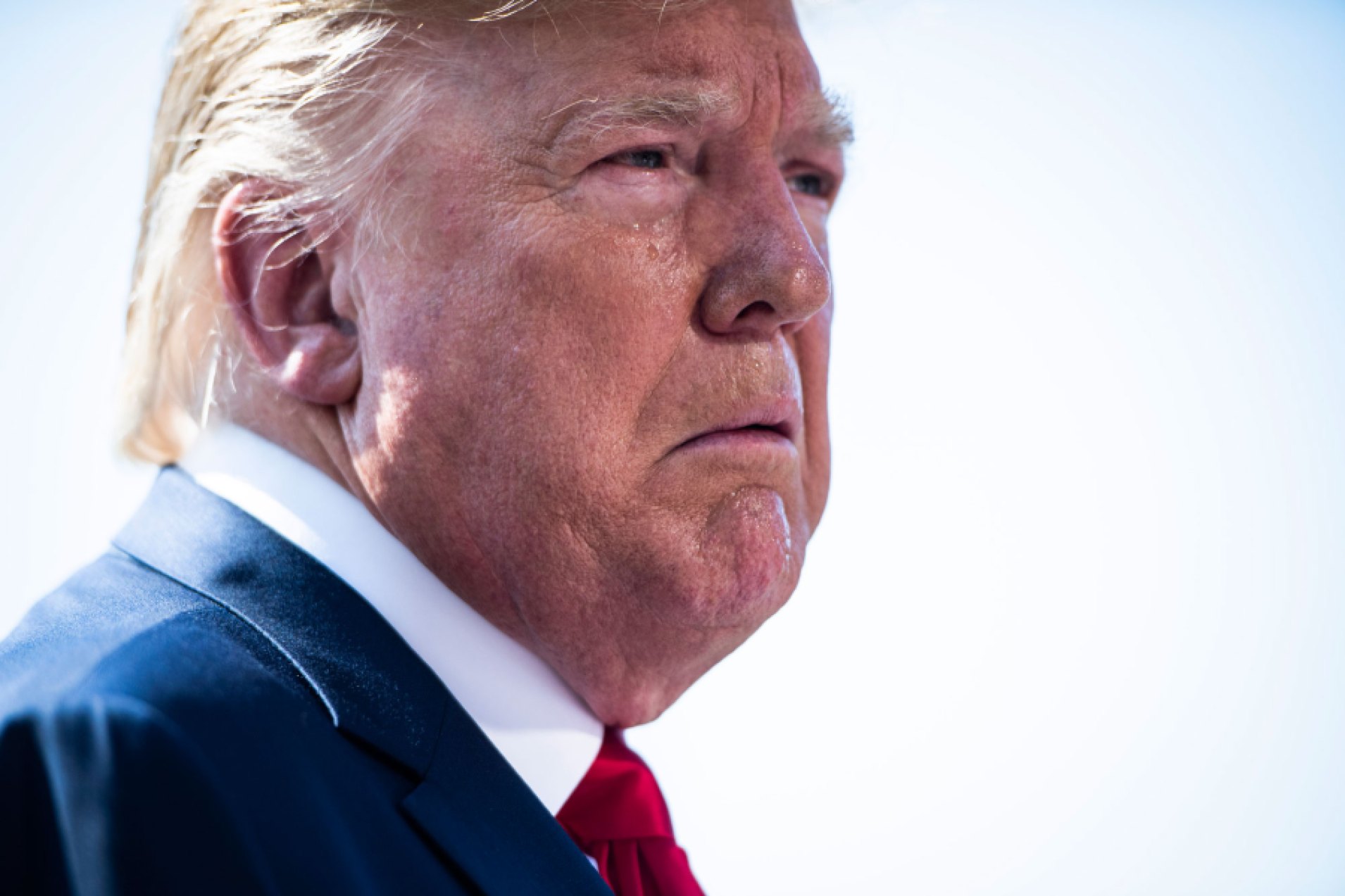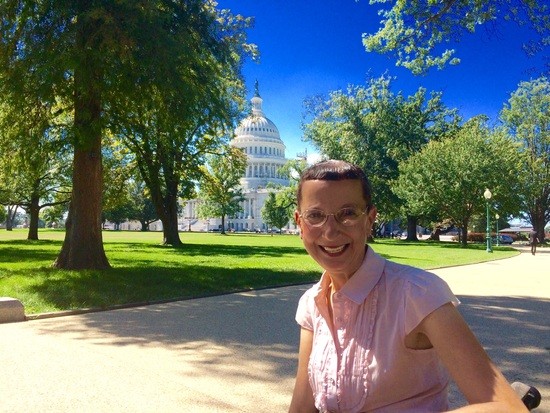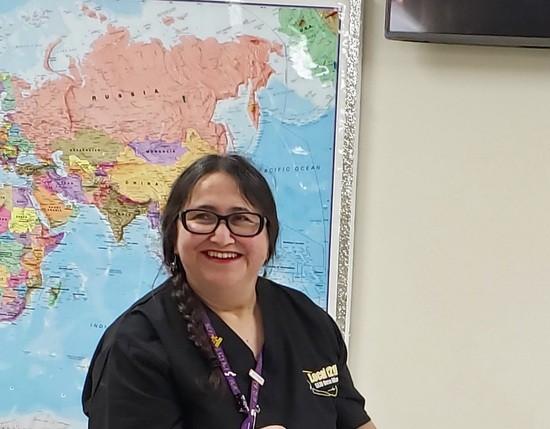
WASHINGTON, DC – AUGUST 9 : President Donald J. Trump stops to talk to reporters and members of the media as he walks to Marine One to depart from the South Lawn at the White House on Friday, Aug 09, 2019 in Washington, DC. (Photo by Jabin Botsford/The Washington Post via Getty Images)

Share
This story was originally published by Prism Reports
The American Nurses Association (ANA), one of the largest professional nursing organizations in the world representing the interests of 4.2 million registered nurses, recently rescinded its presidential endorsement policy, choosing 2020 as the first time in decades the powerful trade organization will not endorse a presidential candidate.
The timing is curious.
The 2020 election is one that “could break America,” The Atlantic recently reported, and Americans have lost more than 200,000 loved ones to the COVID-19 crisis, which the White House has largely treated as a partisan issue—pretending the highly contagious disease is not deadly.
The outright rejection of science and the lack of federal response and aid has meant that the coronavirus has firmly rooted in the United States, leaving healthcare workers on the frontlines ill-equipped to handle the overwhelming caseload and scrambling for basic resources like Personal Protective Equipment (PPE). These harsh and risky working conditions not only violate the rights of registered nurses, according to a damning report released in September by the National Nurses United, one of the largest nurses unions in the country, but have resulted in the deaths of an estimated 1,718 healthcare workers.
During the pandemic, tensions have grown between longtime ANA members and the organization’s leadership, according to nurses who spoke to Prism. The ANA’s attempt to appear nonpartisan by refusing to speak out against President Donald Trump’s disregard for science and his defiance of public health officials has led longtime ANA members to break with the organization.
‘Gross malpractice’
In May, when the COVID-19 death toll surpassed the number of U.S. military deaths in the Vietnam and Korean wars combined, the ANA’s president, Ernest J. Grant went to the White House for a National Nurses Day event in which Grant, President Trump, and other nurse leaders did not wear masks. (Just four months later, the president and other senior White House officials would test positive for the coronavirus just days after they refused to wear masks during a tightly-packed “super-spreader” event in the White House Rose Garden.)
Jerry Soucy, a Massachusetts registered nurse with more than 40 years of experience in serious illness and end-of-life care, called the National Nurses Day event “gross malpractice.”
“When all of those nurse leaders jammed into the Oval Office, shoulder-to-shoulder with no masks during a pandemic, it was egregious,” Soucy said. “Any nurse with a real commitment to this work would have said, ‘I can’t do it. If I can’t have my mask on, I’m not going to participate.’ But no one said that.”
The ANA appears to be making a concerted effort to toe the line during the 2020 election. In August, a West Virginia nurse named Amy Johnson Ford (also known as Amy Jolene Thorn and Amy Johnson) spoke at the Republican National Convention praising Trump’s response to the COVID-19 crisis. RN Action, the policy and advocacy arm of the ANA, tweeted that it was “great to see nurses featured in both conventions,” using the hashtags #ThankANurse, #NursesVote, and #RNC2020. The organization later deleted the tweet, saying on Twitter, “We recognize our posts highlighting nurses involvement in both national conventions may be construed as supporting the respective candidate.” (The West Virginia nurse was arrested and charged earlier this month with allegedly shooting another woman in the stomach.)
The ANA has also refrained from explicitly blaming the Trump administration for the federal government’s abject failure to provide resources and guidance during the pandemic.
Last month, the ANA released findings from its nationwide COVID-19 survey of more than 21,000 U.S. nurses, 42% of whom say they are still experiencing widespread or intermittent PPE shortages. Without mentioning Trump, the organization called on the “administration and Congress” to address the insufficient PPE supply; implement the full use of the Defense Production Act; pass the Medical Supply Chain Emergency Act of 2020; and expand investment in testing and public health infrastructure. Not only has the Trump administration outright refused some of these measures, but medical supply chains have experienced a “catastrophic collapse” under the Trump administration, a recent Associated Press and Frontline investigation found—and this collapse is one of the “most consequential failures to control the virus.”
In the midst of the pandemic, the Trump administration has also fought diligently to end the Affordable Care Act (ACA), which is the only source of health care for more than half a million people who lost their health insurance amid the pandemic’s economic shutdown. This doesn’t even include the 135 million Americans with pre-existing conditions who would be stripped of health care if the Trump administration successfully strikes down the ACA.
“This is simply not the time to be neutral,” said Teri Mills, a nurse, educator, and advocate whose career spans more than four decades. Mills has been a member of the ANA for more than 30 years and she is a prominent member of Oregon’s nursing community who was named Oregon Nurse of the Year in 2019.
The ANA’s push to appear nonpartisan has actually made it appear as if the organization is signing off on the Trump administration’s deadly inaction, longtime ANA members told Prism, and some are beginning to wonder if the organization’s decision not to endorse a presidential candidate has more to do with appeasing its membership base.
‘The ugly reality’
In 2019, the ANA’s membership assembly—the governing and official voting body of the ANA composed of 200 representatives—overwhelmingly voted to rescind the organization’s 1984 policy of endorsing a presidential candidate. According to a Sept. 14 email from the ANA, 87.7% of the membership assembly was in favor of ending the practice of endorsing a candidate, pushing the board to consider “whether it was in the best interest of the association’s mission, politically diverse membership, and long-term goals to endorse in the 2020 presidential election,” according to the email.
The decision to rescind the policy was ultimately upheld in a closed ANA board of directors meeting. In its place, the ANA adopted a “Presidential Engagement Policy” that encourages nurses to “get out and vote,” according to an open letter from Grant, who characterized the decision to rescind the policy as “one of the most important and toughest decisions” the board has ever made. Grant also acknowledged the nation is “in the middle of one, if not the most, divisive election in history.”
Mills told Prism she can still remember the day in 2019 when the membership assembly voted to rescind the policy. The nurse and educator said she was the only one at the meeting who spoke out against the decision. As an ANA member for over three decades, Mills said it’s “not easy” to speak out against the organization, but she felt “strongly compelled to” because the ANA is violating its own Code of Ethics by refusing to denounce Trump. The nurse is now an active member and supporter of Nurses For Biden, a coalition of nurses nationwide who are organizing to help elect Biden.
Mills expressed her concerns to the ANA leadership to no avail and she has since publicly broken away from the organization because of what she says is the organization’s “betrayal”—its betrayal to nurses on the frontlines of the pandemic, to the American public, and to the Code of Ethics for Nurses. The Trump administration’s racism, treatment of immigrant communities, and failure to respond to gun violence all fly in the face of the ANA’s Code of Ethics, Mills said.

“The first provision [of the code] is practicing with compassion and respect for the inherent dignity, worth, and personal attributes of every person without prejudice. Provision three says we are to promote, advocate for, and protect the rights, health, and safety of the patient. This includes our immigrant population,” Mills said. “It’s like the ANA is saying none of this seems to matter.”
The Oregon Nurse of the Year declined to share any presumptions she may have about why the ANA will not speak out against Trump, but Soucy had no such reservations.
“The ugly truth is the ANA likes to portray nurses as angels and heroes, but we’re not. We’re just people and like the larger American population that is abominably racist, that’s also true of nurses. Just like there are millions of Americans who are right wing white supremacists, the same is true for nurses,” Soucy said.
The nurse told Prism his read on the situation is that the ANA doesn’t want to alienate nurses who are Trump supporters or who subscribe to his worldview.
“They are trying to thread the needle very carefully because endorsing Biden would mean risking exposing the ugly reality that a lot of nurses think Trump is great,” Sousy said.
Demographics for the ANA’s membership are not publicly available, but what is certain is that over the years the organization has overwhelmingly contributed to Democratic candidates, according to data from FollowTheMoney. This includes contributions to Hillary Clinton’s presidential campaign in 2016. Also notable: In June 2018 the ANA’s membership assembly elected Grant, the first ever Black man to serve as the organization’s president. During the summer when a nationwide uprising unfolded as part of the Movement for Black Lives, Grant issued a statement urging nurses to use their voices to “call for change.”
“The Code of Ethics obligates nurses to be allies and to advocate and speak up against racism, discrimination, and injustice,” Grant said in the statement.
Historically, Black nurses were denied membership to national professional organizations like the ANA. The National Black Nurses Association formed in 1971 in part, because Black nurses and the issues they faced were not represented by the ANA. Nursing continues to be a field dominated by white women: More than 60% of registered nurses in the United States are white and more than 88% are women.
Roberta Lavin, a professor of nursing and the PhD program director for the University of New Mexico’s College of Nursing, has been a member of the ANA since 1991. Back in August, she wrote a controversial blog post that outlined her issues with the ANA’s handling of the Trump administration. In it, she shared an exchange with a member of the ANA’s leadership who told her to “overlook” the organization’s refusal to denounce Trump because “they didn’t want to alienate Republican nurses.” After the blog began making the rounds in online nursing circles, Lavin, a longtime registered independent, told Prism a nurse reached out to share that she once tried to write an editorial critical of Republicans for a major nursing publication, but was told it would result in “huge pushback.”
“You need to understand that a good portion of nurses are white, and if you look at the majority of [the nurses], the majority of them are Republican, so it’s self-preservation,” Lavin said.
There is also a real risk is parting ways with the ANA. Academics who want to become fellows of the American Academy of Nursing must be an ANA member in order to be a fellow and a member of the Academy. This is a big deal for universities because when the U.S. News ranks universities, one of the criteria they rank nursing colleges on is how many faculty are fellows of the Academy. Lavin said that if a nurse chooses not to pay ANA dues, because they find the organization to be “immoral and unacceptable,” they could lose their status as a fellow of the American Academy of Nursing, which hurts their university ranking.
Coercive membership aside, the ANA’s refusal to denounce the Trump administration’s racist rhetoric and failed response to the COVID-19 crisis sends a clear message to communities of color hardest hit by the pandemic because of the health disparities they experience—and to Black nurses who encounter insurmountable barriers in the nursing field.
“Nursing as a whole has done a horrible job of increasing representation for all groups who aren’t Caucasian women. Only 6% of nursing doctoral graduates across the country and 6.2% of all registered nurses are African Americans. Nursing remains a field that is predominantly white women from predominantly middle class families and we see the world as middle class white women, which impacts who gets accepted into nursing schools, our definitions of health, and everything else we do,” Lavin said.
Maria Elena Diaz, the only registered nurse of color who spoke to Prism for this reporting, has been in the nursing field for over 30 years and said she can still remember her educators at California State University, Los Angeles urging her to join the ANA.
In the Los Angeles area where Elena Diaz grew up, the demographics of nursing were more diverse than in other parts of the country during the same time period. Elena Diaz was inspired to enter the field when she worked alongside a Black charge nurse at a county hospital where she was a volunteer. After graduating from nursing school, one of Elena Diaz’s first jobs was at Children’s Hospital Los Angeles, where she often translated for immigrant families. While working at the Children’s Hospital, she once accidentally opened up the wrong paycheck and saw that a white junior nurse she’d been training and who went to the same college as her was getting paid $2 an hour more than she was. Not long after, Elena Diaz left the hospital to work more directly in her community.

The California nurse has been an ANA member for decades and she told Prism she chose not to renew her membership with the organization when the ANA confirmed it would not endorse a presidential candidate. It’s not that she believes nurses don’t have the right to be Republicans and conservatives, she said; it’s that compassion and trustworthiness are core values for nurses and the Trump administration is “the opposite.”
“For almost two decades, we have been voted as the most trustworthy profession. That comes with a responsibility to our patients. Where I work, a lot of our patients are low-income and undocumented. I know that health equity is a racial justice issue and that long standing systematic and social inequities have meant that people of color are at greater risk of dying from COVID-19,” Elena Diaz said. “This administration is anti-science and the [the ANA’s] decision not to speak out against Trump just felt like such a sucker punch.”
Nurses who decide to leave the ANA are making a sacrifice because being a member of the organization provides certain benefits. The ANA California chapter where Elena Diaz was a member granted her access to minute-by-minute information on issues that were important to her, including bills she personally lobbied for. Elena Diaz told Prism she will miss the larger community she was tapped into as an ANA California member, and that she is sad for the ANA: The organization is losing someone committed to racial justice in the medical field.
Elena Diaz said it’s important to note that the decision to rescind the 1984 policy for endorsing presidential candidates was not made by nurses like her—who are working in communities of color on the frontlines. The decision was made by nurses with more elite positions in the ANA, she said.
“Nurses like me had no influence on the decision,” Elena Diaz said. “I don’t think our opinions even matter.”
The ANA did not respond to Prism’s multiple requests for comment over the span of one month.

